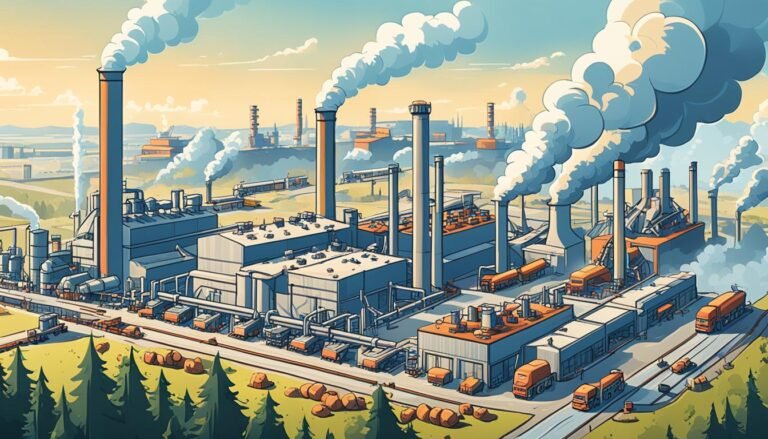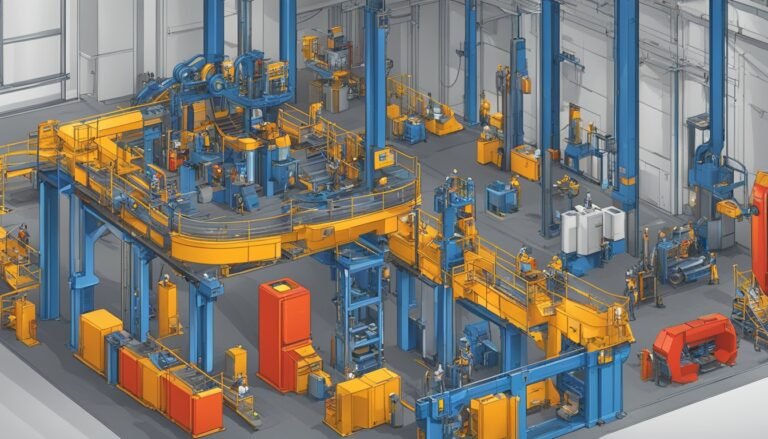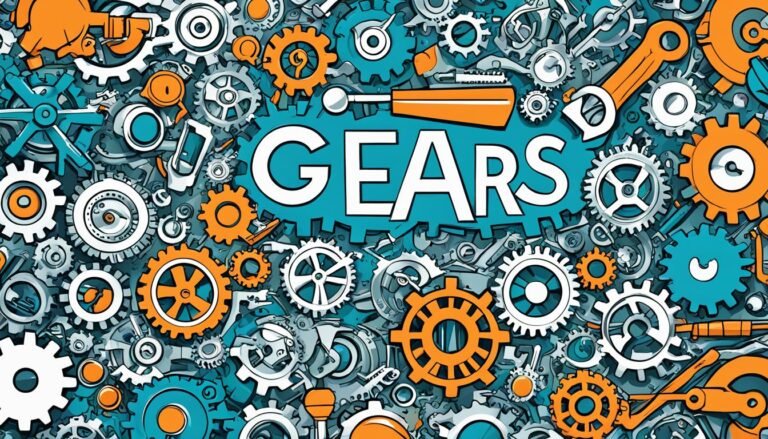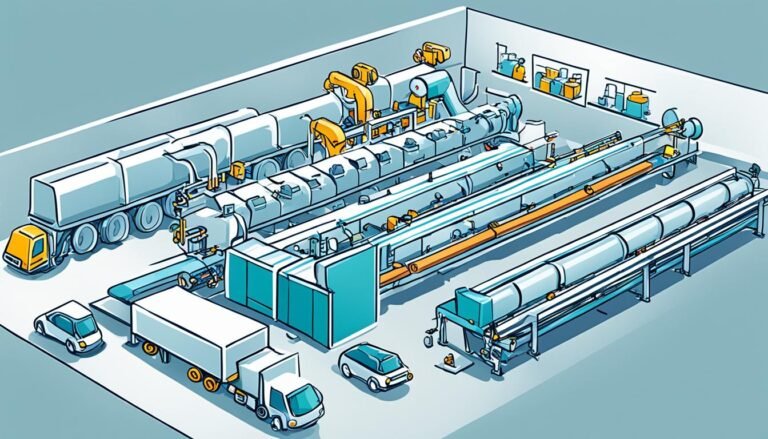Building Resilience and Adaptability in Manufacturing
Did you know 72% of companies are focusing on manufacturing in 2024? This shows how important it is for the industry to be resilient. Challenges like global tensions, climate change, and worker shortages make it key to bounce back well.
Being resilient means more than just recovering from tough times. It’s about creating a place where learning and emotional growth happen. Imagine if companies supported their teams, talked openly about stress, and gave time off to recharge. These actions boost resilience and adaptability in manufacturing, leading to strong and flexible systems.
Adaptability is also crucial, letting companies quickly change and innovate. Using agile methods and flexible leadership helps a lot. Together, resilience and adaptability help a company thrive in a fast-changing business world.
Key Takeaways
- 72% of organizations prioritize manufacturing in 2024, highlighting the need for resilience.
- Challenges like geopolitical tensions, climate change, and labor shortages disrupt manufacturing capabilities.
- Building a culture of continuous learning can support emotional and operational resilience.
- Fostering adaptability through agile methods and flexible leadership is vital.
- Sustainable manufacturing practices improve resilience and adaptability in the industry.
- Transparency and real-time data are crucial for managing disruptions effectively.
- Developing a growth mindset and promoting stress management are essential for workforce upskilling and resilience.
The Importance of Resilience in Manufacturing
Understanding resilience is key for the manufacturing industry. It’s about making a strong plan that helps companies recover and do well when things get tough. This resilience is not just something you’re born with. It’s a process that can be made stronger and cared for.
Understanding Resilience
Resilience in manufacturing means bouncing back fast from problems and keeping operations smooth. The COVID-19 pandemic showed us how important this is, as even strong supply chains struggled. To get better at resilience, companies should use many suppliers and make things in different places. They should also have flexible delivery systems and be ready to change quickly.
Keeping an eye on supply chains in real-time helps lower risks and make quick decisions when problems happen.
Building Emotional Resilience
Emotional intelligence is key to building emotional resilience in manufacturing. It means being kind to yourself, controlling negative thoughts, and having a supportive work culture. With emotional intelligence, companies can keep their workers motivated and ready for stress and tough times.
It’s also important to have strong relationships with suppliers, customers, and logistics partners. These connections help make a strong network that can get through hard times together.
Fostering a Culture of Resilience
To build a resilient culture, companies need to always be improving and manage things well ahead of time. This means having good risk management, using data to see what’s coming, and using new tech like AI and IoT to predict and deal with problems. Investing in resilience keeps companies running smoothly and gives them an edge over the competition.
| Key Points | Details |
|---|---|
| Impact of COVID-19 | Highlighted vulnerabilities in supply chains; emphasized the need for resilience. |
| Diversification | Essential for reducing risks; involves multiple suppliers and locations. |
| Emotional Intelligence | Vital for building internal resilience; supports a motivated and engaged workforce. |
| Technological Innovations | Enhance predictive capabilities and response times. |
| Organizational Commitment | Continuous improvement and strategic investments in resilience. |
The Role of Adaptability in Manufacturing Success
Adaptability in manufacturing means quickly adjusting to changes. It boosts creativity and helps grab new chances. Leaders need to encourage a mindset open to new tech, methods, and ways of doing things. They should keep things efficient too.
Encouraging Flexibility and Openness
Being flexible and open is key in manufacturing. The industry changes fast, so workers need to be ready for new ideas and ways of working. Danfoss shows this with its “Adaptability Academy”. It trains over 40,000 employees each year in Agile, data analytics, and cross-cultural skills.
This has helped Danfoss grow its revenue and start new digital products.
Agile Methodologies
Agile Methodologies are a flexible way to manage projects. They help companies adjust quickly. Deloitte’s “Always Learning” shows how Agile works well. It gives over 10,000 courses to its 300,000+ workers.
This has helped Deloitte adapt to remote work during the pandemic and grow its digital and AI services.
Develop Adaptive Leadership Styles
Leaders need to be adaptable to handle changes in manufacturing. Good leadership means creating a safe space for learning and being flexible. United Way has shown how to adapt by moving to online volunteering and fundraising during the pandemic.
| Company | Initiative | Impact |
|---|---|---|
| Danfoss | Adaptability Academy | Double revenues, diversify product lines |
| Deloitte | Always Learning Philosophy | Seamless remote work adaptation, meeting digital/AI demands |
| United Way | Virtual Engagement Strategies | Effective community service during the pandemic |
Adding Supply Chain Agility to a company’s culture is vital. It helps adapt to demand changes, supply issues, and global shifts by using agile methods. This adaptability lets manufacturing firms succeed in a changing world driven by Digital Transformation.
Building Resilience and Adaptability in Manufacturing
Building resilience and adaptability in manufacturing means using many strategies. This includes good communication, working together, and training. By focusing on Workforce Upskilling, companies can make their employees better. This helps them handle new challenges and technologies like IoT, AI, and machine learning.
Using Lean Manufacturing helps businesses cut waste and use resources better. This leads to operations that are sustainable and efficient. It’s important for factories to use less energy, water, and materials to help the environment.
Being resilient is key for a strong manufacturing plan. For example, a study by McKinsey found that healthy and resilient companies were less likely to go bankrupt. During a tough economic time, resilient companies saw their earnings go up by 10%. Meanwhile, other companies in the same industry saw a 15% drop.
Arup’s work on the Pearl Red Winery project over seven years shows how to be resilient and adaptable. They also worked with Jaguar Land Rover on a new engine plant. This shows how being resilient and adaptable leads to innovation and lasting results.
The idea of Supply Chain Agility is crucial for adaptable manufacturing. Agile supply chains can quickly adjust to changes in the market and disruptions. This keeps operations running smoothly. Using feedback loops for ongoing improvement helps businesses stay ahead and resilient.
Investing in Workforce Upskilling is essential. Training employees in technical and soft skills, like emotional intelligence and problem-solving, creates a flexible and innovative culture. A McKinsey survey found that 80% of executives are changing business meetings to make them more efficient. This shows the shift towards a more agile and resilient business world.
Companies should aim for a balance between being resilient and adaptable. This balance helps them face challenges while keeping an eye on the future. The efforts in Lean Manufacturing, Supply Chain Agility, and Workforce Upskilling create a strong and adaptable manufacturing environment.
Leveraging Digital Transformation for Increased Adaptability
Manufacturers are now investing in digital transformation. They use smart factories and the Industrial Internet of Things (IIoT). This makes them more adaptable to market changes. About 80% of manufacturers have increased their digital tech spending in recent years.
The Impact of Smart Factory Technologies
Smart factory technologies help collect and process data in real-time. This leads to better decision-making and more efficient operations. By using smart automation and analytics, manufacturers can cut costs by up to 90% and boost productivity.
Hyperautomation in manufacturing cuts down human errors and optimizes workflows. This makes businesses more resilient and agile.
The Role of Industrial Internet of Things (IIoT)
The Industrial Internet of Things (IIoT) changes manufacturing by connecting machines, sensors, and systems smoothly. IIoT lets manufacturers get real-time data from sensors. This data is key for process visibility and predictive analytics.
This detailed monitoring ensures smooth operations. It also lets manufacturers take action early on potential issues.
Predictive Maintenance Strategies
Predictive maintenance is key in modern manufacturing. It uses data analytics to predict equipment failures. This way, maintenance can be done before it’s needed, avoiding downtime.
Predictive maintenance also makes machines last longer and improves overall efficiency. By looking at production data, manufacturers can find bottlenecks and make processes leaner.
Developing Workforce Resilience and Adaptability
In today’s fast-changing world, having a resilient and adaptable workforce is key. By focusing on training and upskilling, promoting a growth mindset, and encouraging open communication, companies can make their employees ready for the unexpected. This creates an environment where everyone feels prepared for change.
Training and Upskilling
Workforce upskilling is very important. The Mercer 2020 Global Talent Trends Study says it’s a major trend. It means teaching employees advanced critical thinking and project management skills. This way, companies can make sure their workers can handle new challenges and tech.
Promoting a Growth Mindset
A growth mindset in the workplace means seeing challenges as chances to learn and grow. It’s key for resilience, making people more flexible and proactive when things change. Classes on self-management and leadership that focus on emotional intelligence help build this mindset.
Encouraging Open Communication
Good communication is crucial for a resilient and adaptable team. A place where everyone shares ideas freely builds stronger teams ready for uncertainty. The American Psychological Association says staying connected helps avoid the worst during quiet times. Regular, meaningful talks between managers and teams also helps build resilience.
| Key Area | Focus | Benefit |
|---|---|---|
| Training and Upskilling | Critical Thinking, Project Management | Prepared for New Challenges |
| Promoting a Growth Mindset | Embrace Challenges, Resilience | Adaptability, Proactivity |
| Encouraging Open Communication | Regular Conversations, Idea Sharing | Stronger Teams, Better Navigation of Uncertainties |
By using these methods, companies can make their workforce resilient and adaptable. This helps them do well in the changing manufacturing world.
Implementing Risk Management Strategies
Using risk management strategies is key for making manufacturing more resilient and adaptable. Most companies see resilience as a big part of their strategy. Also, 52 percent are really good at handling financial risks, showing they’re ready for challenges.
Adding risk management strategies helps in getting ready for different threats. About 60 percent of companies feel they’re really good at bouncing back, showing they’re ready for anything. This includes being prepared for big events like the pandemic, where many saw the need for better risk and resilience.
Promoting Sustainable Manufacturing Practices goes hand in hand with good risk management. These practices keep operations going strong, keeping the company and the planet safe. Most risk managers think improving the risk culture and making resilience a key part of strategy are key steps to get stronger.
Metrics like time-to-survive and time-to-recover are important for checking how strong a supply chain is. A longer time-to-survive means operations can keep going, and a quick time-to-recover shows a company can bounce back fast. Using strategies like getting supplies from many places and managing inventory well helps stay flexible and ready for surprises.
Risk and insurance managers are key in making things resilient, especially in keeping operations and technology safe, showing they’re more involved in making things strong.
Also, sustainable manufacturing practices help make manufacturing more resilient and adaptable. Over 75 percent of companies have set up safety measures for the workplace and remote work to get through the pandemic well.
Tables like the one below give us a closer look at how strong different organizations are in resilience:
| Resilience Area | Capabilities in Place (%) | Role in Organization |
|---|---|---|
| Financial Risks Management | 52 | High Readiness |
| Operational Resilience | 60 | Strategic Integration |
| Digital/Technology Resilience | 75 | Workplace Safety |
By looking at these metrics and strategies, manufacturers can protect themselves from disruptions. This helps them keep growing and thriving in the industry.
Conclusion
Building resilience and adaptability in manufacturing is key for long-term success. Only 21% of product companies say they are highly resilient, showing a big need for improvement. To overcome challenges, manufacturers should work closely with suppliers and use lean manufacturing.
Technological advancements like digital transformation and automation help improve manufacturing. They make it easier to monitor production and manage complex data. For example, Propel helps companies stay connected with their supply chains, boosting resilience and efficiency.
Automation is also vital for dealing with challenges like remote work and workforce shortages. It helps keep production levels high. The focus on sustainability and energy efficiency is also crucial for success. Companies like Mercedes-Benz aim to cut CO2 emissions by over 50% by 2030.
The EU will make companies report on sustainability from 2024. This shows how important it is to be open and responsible. By focusing on sustainability, companies appeal to younger customers and build loyalty.
Using lean manufacturing and digital tech helps manufacturers stay strong and flexible. This approach is not just a response to problems. It’s a way to excel and grow sustainably.
Source Links
- Building resilience in manufacturing
- You’re a Manufacturing Operations professional. How can you develop resilience?
- The Importance of Supply Chain Resilience
- Definition, Strategies, and Best Practices
- Adaptability and Resilience
- Adaptability: The Critical Skill for the Future of Work
- The Importance of Adaptability and Resilience in Your Corporate Wellness Career
- Resilient and adaptive industrial and manufacturing spaces
- Raising the resilience of your organization
- How digital transformation helps brand manufacturers build resilience
- Building Resilience in Manufacturing through Digital Transformation: Lessons and Best Practices
- The Future of Work is a Flexible, Adaptable, and Resilient Workforce | Consulting and Training Solutions | Kepner-Tregoe
- Resilience and Adaptability: How You Lead Matters
- First comes the workforce
- From risk management to strategic resilience
- How to Improve Supply Chain Resilience | SafetyCulture
- Manufacturing Resilience: Key Considerations for Success
- Building Resilience in Manufacturing with the Power of Data | Splunk







